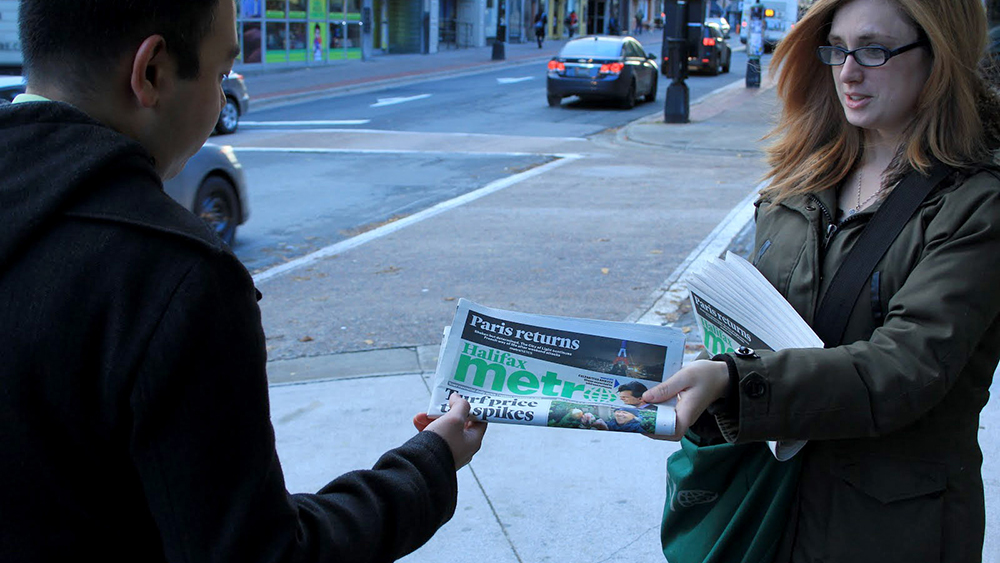Under the covers at Metro Halifax

caption
Does this free daily tabloid deliver more than quick-fix news?
Paws is missing and Jon Stickney suspects he’s been cat-napped.
Plagued by the image of his deserted apartment steps in Halifax’s working-class Fairview neighbourhood – the last known location of Paws, his adopted cat – Stickney phones Metro Halifax.
His distressed message prompts an immediate reaction in the newsroom. Managing Editor Philip Croucher summons reporter Haley Ryan from her cubicle.
Ryan questions Stickney carefully over the phone. The interview doesn’t last long – Paws has been missing for two days, and time is of the essence.
After the interview, Ryan heads to Croucher’s office. She encourages him to publish Stickney’s story. Shortly thereafter, the case of Paws’ disappearance is posted to Metro Halifax’s website.
Croucher turns his attention to the rest of his work.
“I’m excited to see what the day holds,” says Croucher, of working at Metro. “You never know what’s going to happen.”
Stickney’s story might not have made the cut for a Metro newsroom in a different city. As a general rule, free dailies like Metro tend to invest little in local reporting. Instead, they target metropolitans and commuters who want to fill 20 minutes on a bus, subway or train with quick, syndicated news.
But Metro Halifax is a little different. Halifax isn’t a big metropolis and its weak public transportation system is less than ideal for freesheet distribution. Metro Halifax still follows the same basic recipe as a typical free daily: short and sweet with a heavy dose of wire copy – except, according to its editor, this version is served with a twist: local investment.

caption
Managing Editor, Philip Croucher, beside his favourite Metro Halifax articles.Croucher says when Metro Halifax arrived in 2008 under a cloud of controversy, it was criticized for not being “real” journalism and dismissed as a free tabloid that would never last.
Seasoned Halifax journalists might recall Halifax’s Daily News, a beloved local paper that was abruptly replaced by Metro in 2008.
Croucher had worked as a sports reporter and editor at the Daily News for five years, until it ceased publishing. Like many Daily News reporters, he went on to work at Metro Halifax, where he has been managing editor since 2009.
Jack Romanelli, ex-editor of the Daily News, says that paper was an alternative voice to Nova Scotia’s long-established daily, the Chronicle Herald.
After the Daily News shut down, local and national reporters declared their indignation. The Canadian Association of Journalists reported that the closure was a “dangerous trend to ‘News Lite.’” But Croucher’s workday is anything but “lite.”
He arrives at Metro’s office on Halifax’s Barrington Street at 9 a.m., working with a reporter to update the paper’s news site and Twitter feed. The story meeting starts at 10:30 a.m., where Croucher assigns and approves story ideas. By 6 p.m., the stories are filed, laid out and sent to page editors in Toronto, who fill in the other two-thirds of the paper with syndicated news.
“The day really never seems to end,” says Croucher.
Croucher says he’s proud of the stories produced during these long hours in the newsroom – so much so, he’s dedicated a wall to them in his office. He says Metro Halifax works hard to focus on issues important to all Haligonians – not just those in the downtown core.
“We find we’re hitting the stories that maybe other people aren’t,” says Croucher. “That, to us, proves that we’re doing the right kinds of stories that people are interested in.”
A project he’s most proud of was a four-part series about being LGBTQ in Halifax. Tired of the same-old yearly Pride Parade coverage, Croucher says he felt “it was time to dig deeper.”
The series was printed over the course of four days and included an interview with a married lesbian couple raising their son, and an article about educating youth on what it means to be transgender, among other topics. The article “‘Dyke on the shift:’ Intolerance, isolation for gay police detective when she joined force,” explored homophobia in the Halifax Regional Police force.
“I think those stories need to be told,” says Croucher. “Any chance we get to do that, we try to do it.”
But not everyone agrees Metro Halifax is doing a good job. Local journalists are skeptical about whether this free daily giant can serve up quality local content.
Christine Oreskovich, publisher at Halifax’s alternative-weekly newspaper, the Coast, says local readers are passing time with Metro – not spending time.
“It’s the McDonald’s of newspapers. It’s a machine,” she says. “When I get off the subway in Rome, I’m handed the exact same newspaper as I’m handed on Spring Garden Road.”
Oreskovich isn’t alone – Metro is often criticized for lacklustre local content and advertorials.
In 2013, Metro Halifax printed “Dexter in tune with today’s families,” a cover story about Darrell Dexter, former Nova Scotia premier. The article was a paid advertisement.
Metro was criticized for the ad by readers and journalists. An article by J-Source, an online publication that reports on issues in journalism, revealed that many people agreed the ad was deceptive and unethical.
Metro is also criticized for providing few jobs for local journalists. Oreskovich says the Coast hires 17 local editors, designers, salespeople and production staff, as well as 100 freelancers throughout the year – while Metro Halifax has a full-time editorial staff of six.
Metro Halifax also swallowed up national advertising for the Coast when it arrived in 2008.
Oreskovich shares a sentiment held by many journalists: that Metro Halifax launched to provide advertisers with a coast-to-coast audience.
Oreskovich says Metro isn’t a local newspaper. She says the Coast, on the other hand, is “on the ground in the community.”
“You might pick it up to do your Sudoku puzzle, but I don’t think you’re going there to find out what’s happening in Halifax,” says Oreskovich.
Croucher disagrees.
He says Metro Halifax is breaking stories – like the Halifax transit strike in 2012. He says Metro reporters were “prepared” and waiting at the scene at 1:45 a.m., and were the first to break the news.
“I think we’ve clearly proven people wrong,” says Croucher. “We’ve showed that we are covering journalism just as well as anybody else.”
Free-for-all
Metro International introduced its free daily chain to Canada in 2000. By 2008, Metro had planted its offices in Calgary, Edmonton, Vancouver, Toronto, Ottawa and Halifax. Star Media Group, under Torstar Corp., owns Metro newspapers across English Canada.
DeNel Rehberg Sedo, communications professor at Mount Saint Vincent University in Halifax, says free dailies like Metro offer similar styles to “broadsheets of the past” – serving up intrigue, a little bit of drama and just enough local content.
“You have to give them credit for being so aggressive in all of the different markets. They obviously have something that’s working,” says Sedo.
Metro Canada Editor-in-Chief Cathrin Bradbury says Metro readers want a grab bag of content including local, national and international news, as well as entertainment and sports coverage. She says nationally, Metro has tripled its local coverage over the past few years.
“We gotta remember the name at the top,” says Croucher, pointing to the Metro Halifax logo. “Readership has shown (that) people are picking us up for our local coverage.”
Piet Bakker, a professor of mass media at the HU University of Applied Sciences in Utrecht, Netherlands, has studied the free daily model, including Metro, in depth. He says free dailies offer a solution to an “ailing business model” by introducing newspapers to people who have never read one before.
Still, Metro’s success in Canada hasn’t been able to match that of paid local papers. In 2014, Metros in London, Regina and Saskatoon closed down. In 2008, Metro Toronto had a daily circulation of 260,000 but by 2014 this number had dropped to 220,771, compared to 332,800 for the Toronto Star.
In 2014, the Chronicle Herald had a daily circulation of 91,152 compared to 43,928 for Metro Halifax.
Bakker says the 2008 financial crisis is partially to blame – newspaper advertising budgets collapsed and circulation dropped. But he says competition between free dailies also played a role in their decline. Freesheets flooded markets in cities where Metro had found success – and only one free daily can be successful in any given market.
J-Source published an article in 2008 that reports Metro’s arrival “sparked a fierce newspaper war” and an “explosion of (free) daily newspapers across Canada” – although this didn’t happen in Halifax.
Bakker says free dailies are currently competing with smartphones and the Internet for commuter attention.
Celebrating Metro
Stephanie Taylor, former city hall reporter for Metro Halifax, says Metro is the “underdog” local newspaper. And she isn’t the only one who thinks Metro deserves more credit.
In an article for the Guardian, a British national daily newspaper, author Peter Preston argues that Metro is “worth celebrating,” despite being a freesheet.
Metro isn’t traditional – but like paid newspapers, TV news and radio news, it reaches its target audience.
“We’re not the paper of record, we’re not CBC,” says Taylor of Metro Halifax. She says it feels good to see established local news outlets follow the stories Metro is breaking.
Taylor graduated from the journalism program at the University of King’s College in Halifax in May 2014 and started working at Metro Halifax in August of that year. She says she interned for The Chronicle Herald and did some work for other local publications.
She says the Chronicle Herald had a “more classic newsroom feel” but at Metro Halifax “it’s all hands on deck.” Taylor says this “classic newsroom” includes numerous reporters, departments and more management.
In November 2015, Taylor moved to become a senior reporter at Metro Winnipeg. “(Metro Halifax) is entirely driven by the drive and energy of the people who work (there),” says Taylor. She says Metro reporters are “passionate about the stories they’re telling.”
Metro Canada Editor-in-Chief Cathrin Bradbury says she wants Metro to be recognized for its quality journalism. In 2016, Bradbury plans to enter Metro articles from different local hubs across Canada in the National Newspaper Awards, an organization that honours the best Canadian journalism.
In 2015, Metro Vancouver was nominated for the first time for Best News Reporting of the Year (Print), at The Jack Webster Awards for Excellence in British Columbia Journalism.
Jack Romanelli, ex-editor of the Daily News, says losing the Daily News to Metro was not a good thing for Halifax, but he admits Metro Halifax is one of the best Metros in Canada.
“They make every word count,” says Romanelli.
‘The cat that came back’
Paws was discovered close to home 20 minutes after Metro Halifax posted the story about his disappearance.
Jon Stickney attributes this victory to the missing-cat flyers he had been distributing for two days, but Croucher keeps the article on Metro Halifax’s website.
He republishes the story as “The cat that came back,” the tale of a local man in search of his missing feline. He says Metro Halifax doesn’t take itself too seriously all the time.
“We like to have a little fun.”
Besides, Paws’ disappearance matters to this Haligonian, so it matters to Metro.

